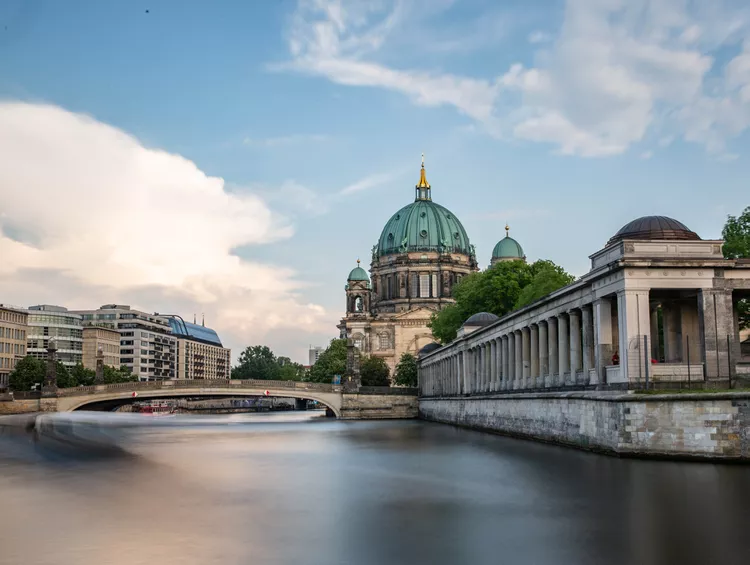Best of Art and Culture in Berlin
Berlin is home to more than 170 museums and galleries, many housing the finest and most significant art collections in the world. If you want to immerse yourself in a day of culture in Berlin, explore this overview of the best museums in the city, featuring historical exhibitions and modern art collections.
Museumsinsel

Museum Island, located in Berlin’s historic heart, is home to five world-class museums. This unique ensemble of historic buildings, all constructed under different Prussian kings, is recognized as a UNESCO World Heritage site. Visitors can explore some of the finest art collections in Germany, featuring everything from the famous bust of Egyptian Queen Nefertiti to European paintings from the 19th century.
Jewish Museum in Berlin

The Jewish Museum chronicles the rich history and culture of Jewish people in Germany from the Middle Ages to the present day. Don’t miss its extensive exhibitions housed in a remarkable building designed by Daniel Libeskind. The striking architecture features a bold zigzag design, with underground tunnels connecting the three wings, irregularly shaped windows, and captivating voids that invite exploration.
Neue Nationalgalerie

Berlin’s New National Gallery, located at Potsdamer Platz, showcases international art from the 20th century. Set in a modern building, known as “the temple of light and glass,” the museum was designed by Bauhaus architect Mies van der Rohe and is home to masterpieces by renowned artists such as Munch, Kirchner, Picasso, Klee, Feininger, Dix, Kokoschka, and Richter.
Gemäldegalerie

The Picture Gallery at Potsdamer Platz offers one of the world’s finest collections of European art from the 13th to the 18th century. With nearly 3,000 paintings, you will find masterpieces by Bruegel, Dürer, Raphael, Titian, Vermeer, Caravaggio, Rembrandt, and Rubens.
Museum für Fotografie

The Museum of Photography showcases the evolution of photography from the 19th century to the 21st century in a neoclassical building dating back to the early 1900s. Additionally, it houses the Helmut Newton Foundation, which celebrates Newton’s work with a series of temporary exhibitions as well as an exhibit featuring the artist’s personal items.
Deutsches Historisches Museum

A must-see for history enthusiasts is the German Historical Museum (DHM), situated in one of the oldest and most majestic buildings along the boulevard Unter den Linden. This museum provides a comprehensive overview of Germany’s 2,000-year history, culminating with the fall of the Berlin Wall in 1989. Be sure to explore the newly built wing of the German History museum, designed by I.M. Pei, featuring a modern hall with a stunning glass spiral staircase.
Bauhaus Archiv

Berlin’s Bauhaus Archive Museum of Design is home to the world’s largest Bauhaus collection, offering rich insights into the German avant-garde school. This museum is housed in a building designed by Walter Gropius, the founder of the Bauhaus school, and showcases a fascinating collection made by Bauhaus teachers and students, including ceramics, furniture, sculptures, weaving, printing, and bookbinding.
Hamburger Bahnhof

The Museum for Contemporary Art in Berlin occupies a former train station built in 1874. This museum focuses on contemporary art from the latter half of the 20th century onward, featuring paintings, sculptures, graphics, photography, video, and installations by international artists such as Andy Warhol, Cy Twombly, Robert Rauschenberg, Roy Lichtenstein, Joseph Beuys, Jeff Koons, and Pipilotti Rist.
Kupferstichkabinett Berlin

Berlin’s Museum of Prints and Drawings features one of the most significant graphic art collections globally. With over 500,000 prints and 110,000 drawings, watercolors, and oil sketches from various epochs, among them masterpieces by Botticelli, Dürer, Rembrandt, Picasso, and Warhol.
Berlinische Galerie

True to its name, the Berlinische Galerie focuses on art produced in Berlin from 1870 to the present. The museum offers fascinating insights into the artistic developments of the German capital throughout the past few centuries, including movements such as secessionism and Dada, the New Objectivity, Expressionism, as well as the impact of the Nazi regime on the art scene in Berlin today.





